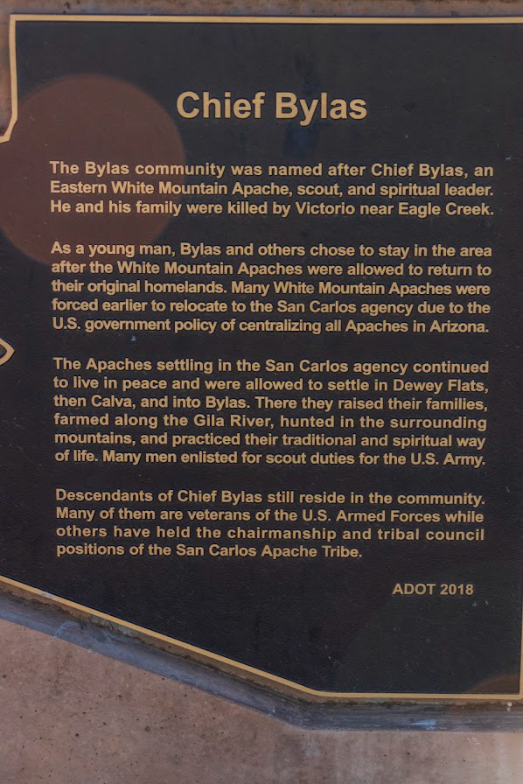History marks the spot alongside US 70
History marks the spot alongside US 70

If there is one motto that we would like all drivers to observe, it's buckle up and drive safe.
But if there are two mottos we would like all drivers to observe, it's buckle up and drive safe and to always take time to read historical markers.
State highways take you to some incredible places, often by ways of small towns or communities that have a lot more history than you think. Take US 70, for example, as it traces a path between Globe and Safford, moving through the San Carlos Reservation. An intrepid ADOT employee was recently in the area and snapped a few shots of historical markers along the way.
For example, you may have driven through the community of Bylas, but did you ever stop to wonder how it got its name? Turns out that if you stop at a monument erected in 2018, you will find that Bylas is actually the name of an Eastern White Mountains Apache chief. Bylas (or Bailish depending on your transiteration of the original Apache) settled in the area when the White Mountain Apache were forced to relocate to San Carlos in the 1870s. Even after they were allowed to return to their traditional lands, Bylas and his family chose to stay and build their lives there.
Though Chief Bylas and his immediate family were killed by the chief of the Warm Springs Apache, some of his descendants still live in the community named after him.
Just down the road from Bylas you'll pass another historical marker for the former community of Geronimo. As you might have guessed, the location was named for THE Geronimo, whose stiff resistance to the U.S. Army made him one of the most well known Native Americans ever.
So famous, in fact, that we aren't going to get into the life and times of Geronimo the man here. But the marker did get us curious so we looked a little more into the community of Geronimo.
In his book, "Roadside History of Arizona," state historian Marshall Trimble states that the community, just across the boundary of the San Carlos Reservation, was a haven for outlaws and others on the lam during warmer weather. Because most of the buildings were flat-roofed adobe, someone on the run would get on roof, pull up the ladder after them and get a good night's sleep without having to worry about being surprised.
But Trimble spends most of his time describing Geronimo's resident con man, "Doctor" Richard Flower. Flower was a consummate snake-oil salesman, hawking a cure-all he claimed would help everything from baldness to a toothache. Trimble makes sure to point out "Doc Flower's" recipe had no actual value besides having a lot of alcohol mixed in.
However, the good doctor decided to move past his penny-ante operation and get into the big times. To that end he gathered up his ore, headed east and started selling shares in the "Spendazuma" mine. Mining was big business in those days and eager investors were always looking for the next big strike, like those that had launched Tombstone, Wickenburg or Prescott.
There was just one problem.
A newspaper reporter went to see this mine that was exciting so much interest, and found nothing more than an elaborate set. As you can imagine, the paper ran that story and Flower's investors evaporated.
Whew – that is a lot of history and we got that from looking at just two markers that are relatively close together! Imagine what else you can learn from stopping at the many others set up along the highways and at rest areas across the state.
Just please promise us you will drive safely to go see them.
